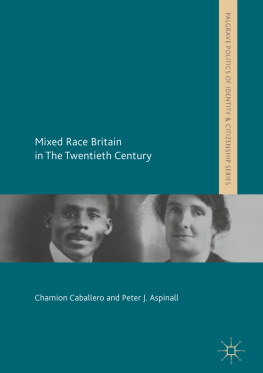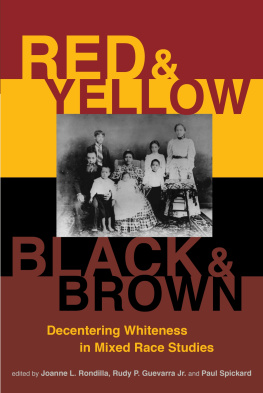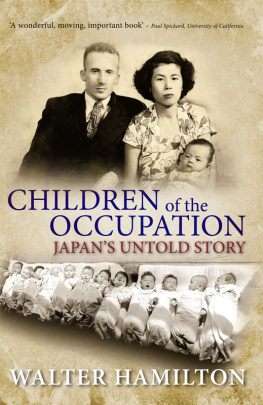1. Introduction
In the decennial 2011 Census , 1.2 million people2.2 per cent of the populationwere enumerated in the Mixed group in England and Wales. One year later, the heptathlete Jessica Ennis-Hill, a gold medallist winner in the 2012 Olympic Games and the daughter of a Jamaican father and an English mother, was heralded in the media as not only the face of the census but the face of the Olympics.that, as in America, was putting the country on a path to a post-racial future in which race itself was becoming increasingly irrelevant. Yet a century earlier, people in racially mixed unions and their children were generally denigrated by the wider society as degenerate, feckless outsiders, and frequently cast as unworthy of social citizenship. How did this radical transformation come about? What were the moments, events and movements in the history of the nation that brought about such massive change? In this book, we set out to illuminate the longstanding but often hidden or ignored history of racial mixing and mixedness in twentieth century Britain, drawing on both more familiar episodes of Britains racial past as well as events and experiences which are less recounted or known.
The history is, in fact, an entanglement of many stories, of different and often competing discourses not only over the course of the twentieth century but of many preceding centuries. From the outset of Britains imperial expansion, racial mixing was rife. Often horrendously forced, at other times freely entered into, interracial contact, liaisons and unions were at the heart of the colonial and colonised experience. In Britain too, with a minority ethnic presence dating back to Roman times, interracial relationships were not unfamiliar: in 1578, Captain George Best commented that he had seen an Ethiopian as black as coal brought to England, who taking a fair English woman to wife, begat a son in all respects as black as the father,).
While such relationships were certainly viewed unfavourably in certain quartersat the turn of the nineteenth century the journalist William Cobbett raged at the shocking number of English women who were prepared to accept not only black lovers, but much worse, black husbands (Fryer ).
While back at home the end of the nineteenth century saw less visible racial mixing due to the gradual decline in the minority ethnic population, the issue of interraciality did not disappear from the public view. In fact, discussion of the demerits of Eurasians). As our own presentation of this history shows, such globalised understandings would come to heavily influence perceptions of the occurrence of racial mixing and mixedness that would increasingly ebb and flow in Britain from 1900 onwards.
The twentieth century history of racial mixing and mixedness in Britain is thus founded on a long history of conceptualising and representing interracial people, couples and families in shifting but particular ways. Yet the twentieth century also not only built on but crystallised many of these concepts and representations in ways that continue to shape the perceptions and experiences of those mixing and of mixed race today. Early assumptions about the dynamics and patterns of mixed race familiessuch as those by Edward Long, the British colonial administrator and historian, who complained in 1772 about the venomous and dangerous ulcer England was facing due to the fondness of the lower class women in England for having relationships and children with black men (in Fryer these works and approaches reverberated through twentieth century Britain with often detrimental outcomes. For example, in addition to the official widespread castigation of interracial families in the interwar period, the Second World War saw relationships between black American GIs and white British women monitored and intentionally thwarted, and their half-caste childrenlike others of mixed racial backgrounds throughout the centurydeemed as confused misfits, with many ending up in care. Meanwhile, in the aftermath of the war, many families of Chinese seamen and white British women were broken up due to the fathers being forcibly repatriated, whilst for decades after the first large-scale immigration in the late 1940s, those who formed interracial unions were routinely subjected to racism in the neighbourhoods where they lived. Such experiences were shared by interracial people, couples and families throughout the twentieth century with their mere presence provoking or exacerbating the violence of white people in Britain, as evidenced during the numerous race riots, disturbances and attacks that occurred throughout the period.
Against this background of societal denigration, sometimes indifference and neglect, wider social movements, shifts and changes of the twentieth century also left their mark on this population in various ways: the changing tensions between race as biologically defined and its position as socially constructed; shifting definitions of who was deemed fit for citizenship; the displacement of the role of physical anthropology in explaining racial mixing and mixedness and the explosion of scholarly sociological studies, many written by people of mixed race background; the rise in the concepts of multiculturalism, the diversity agenda and the politics of recognition; the rise of popular culture, its dissemination through digital media and the wider interpretative representations of this new group; and the developing statistical governmentality of the nation culminating in the official inclusion of mixed race identities in the addition of the Mixed category in the 2001 census headings.
The course of the twentieth century has thus seen racial mixing and mixedness enter the mainstream in unprecedented ways. As we discuss in our postscript (Chap.
Certainly, throughout the twentieth century, such presumptions were solidly in place and official accounts and mainstream representations paint a grim picture of interraciality throughout most of twentieth century Britain. Yet, the frequency of what appear to be such clear social transgressions cannot help but raise a question mark about the actual everyday experience of racial mixing during this time. With the history of racial mixing and mixedness having long been presented to us largely through, as Balachandran (: 55). Throughout the twentieth century, a number of what we might call mixed race projects can clearly be seen to emerge and evolvethat is, shifts in the ways in which the dynamics of how interracial relationships, people and families are structured and represented, routinised and standardised, and accepted or rejected. In this book, we separate these into four overlapping but yet distinct periods: (1) The march to moral condemnation in 19001939 in which initial often nonchalant attitudes to racial mixing and mixedness in Britain hardened into a wide-ranging condemnatory discourse where earlier obsession with Chinese and white mixing was replaced by concerns about black and white interraciality; (2) 19391949, the period of the Second World War and the immediate post-war years which saw a community with a very different ethnoracial historyAfrican American servicemenbecome the target of miscegenation fears, as well as government intervention that directly led to the separation of interracial families; (3) the change in the national landscape in 19501979 with the arrival of mass migration and a newly visible level of interracial mixing occurring in a social landscape in which scientific racism was on the decline while everyday expressions of racism and prejudice were manifest; and (4) the period from 1980 to 2000 which was transformational with respect to the demography and social position of mixed race people, couples and families, with issues of structured racism and deep-seated prejudice seen as increasingly second fiddle to a national story of a more tolerant multiracial Britain in which racial mixing and mixedness was viewed not only as commonplace and acceptable but also celebratory.





